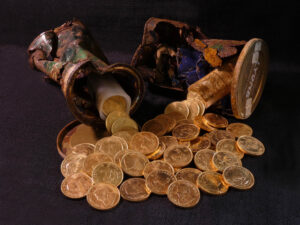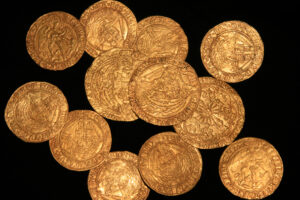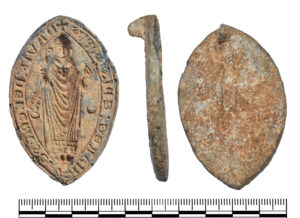The current COVID-19 pandemic has seen a boost in finds from back-gardens recorded with the British Museum’s Portable Antiquities Scheme, as well as an increase in digital recording, especially during ‘full lockdown’ (22 March to 13 May) when metal-detecting was prohibited and in the second ‘lockdown’ (from 5 November), with restrictions on how people exercise. During the first lockdown, 6,251 finds were recorded with the PAS and the records of 22,507 finds on the database were updated; so far this year (2020) over 47,000 finds have been recorded. This has included some very special and intriguing discoveries:

A rare find of 50 modern South African Krugerrand 1oz solid gold coins were found by chance in a back-garden in the Milton Keynes area (BUC-944E2C); they were minted by the Rand Refinery in Germiston in the 1970s during the period of apartheid. How they ended up in Milton Keynes and why they were buried are, for the moment, a mystery. The Coroner, who will decide whether they are classed as ‘Treasure’ (under the historic crown right of treasure trove predating the current Treasure Act), will need to determine whether the original owner of the coins (or their heirs) are known. It is hoped that by making the find public, someone with information will come forward to either the Milton Keynes coroner or the British Museum.

63 gold coins and 1 silver coin of Edward IV through to Henry VIII, and deposited in about 1540, were uncovered in the New Forest area, Hampshire as the finders pulled out weeds in their garden (HAMP-EC901C). Ranging across nearly a century, dating from the late 15th to early 16th centuries, the hoard includes four coins from Henry VIII’s reign, unusually featuring the initials of his wives Catherine of Aragon, Anne Boleyn and Jane Seymour. The total value of the coins far exceeds the average annual wage in the Tudor period, but it is not yet clear whether this was a saving hoard which was regularly deposited into or if the coins were buried all at once.
Other Remarkable Items Recorded in 2020
Besides these finds, which will go through the Treasure process and which finders have a legal obligation to report, a number of other interesting items have been recorded in 2020 through the British Museum’s Portable Antiquities Scheme. These include:

A copper-alloy Roman furniture fitting, found in Old Basing, Hampshire (SUR-77CBD4), and dating from c. AD 43–200. It is decorated with the remarkably well-preserved face of the god Oceanus, including intricate seaweed fronds framing the god’s face, beard and moustache. Tiny dolphins beneath each ear swim down towards the god’s chin, whilst serpentine creatures rest on either side of Oceanus’ temples – marine motifs related to the god. So far, no close parallel has been identified among the decoration on household fixtures and fittings for chests, couches or doors of this period, making this item seemingly unique.

Discovered at Dursley, Gloucestershire (GLO-031814), was a lead-alloy medieval seal matrix in the name of David, Bishop of St Andrews, identified as David de Bernham (r. 1239-53). The pointed-oval (vessica) matrix shows the bishop standing in his vestments, with a crozier in his left hand. The inscription in Latin reads ‘David, God’s messenger, bishop of St Andrews’. High-status seal matrices are usually made of copper-alloy or even silver. Given the material, and the relatively low-quality manufacture of this piece, it is thought likely that this is a contemporary forgery, perhaps used to authenticate copied documents.

A copper-alloy medieval mount, typically worn on low slung belts over armour, that has been gilded, silvered and enamelled, was found at Colyton, Devon (SOM-F219CB). Depicting the white boar of Richard III (r. 1483-85), used as the personal badge by Richard, formerly Duke of Gloucester, from at least the 1470s. Badges were produced in large number for his coronation, the investiture of his son (Edward) as Prince of Wales, and worn by his supporters. It is likely, therefore, that this example was from a belt, or similar, used by one of Richard’s retinue or supporters.
Portable Antiquities Scheme Annual Report for 2019
The announcement comes as the British Museum launched the Portable Antiquities Scheme Annual Report for 2019, which details that 81,602 public finds were logged last year, an increase of over 10,000 on 2018’s report. Norfolk yielded the most finds, with 13% of this total, whilst Hampshire and Suffolk account for 7% each. These finds have led to the discovery of exciting archaeological sites, ranging from a high-status Iron Age to Roman dispersed settlement with associated burials in Kent and an Anglo-Saxon cemetery in Lincolnshire, but also a more general picture of how people lived in the past, and where they settled and worked.
The PAS database holds information on over 1,514,000 objects, all freely accessible to the public. The Scheme exists to record archaeological finds discovered by the public to advance knowledge and understanding of British history through research and furthering public interest in the past. Most are found by metal-detectorists – over 90% of 2019’s finds – and a responsible approach to searching finds (as outlined in the Code of Practice for Responsible Metal-detecting) that helps preserve our understanding of these objects and enhance our knowledge of the PAS. The PAS is a partnership project, managed by the British Museum (in England) and hosted by the Amgueddfa Cymru – National Museum Wales (in Wales), and consisting of 40 locally based Finds Liaison Officers (FLOs), whose job it is to record archaeological finds made by the public.
Hartwig Fischer, Director of the British Museum, said “The Portable Antiquities Scheme (PAS) is a unique partnership, that brings together archaeologists, museum professionals, landowners and finders, especially within the metal-detecting community, to better understand, appreciate and protect Britain’s rich past. The British Museum, together with our colleagues in Wales and a network of local partners across both countries, is proud of its role in delivering the PAS and reaching communities across England and Wales.”
Caroline Dinenage, Culture Minister, said: “Like all of us, the British Museum’s Portable Antiquities Scheme has had to adapt in recent months but it is brilliant to see the scheme growing from strength to strength during lockdown thanks to garden discoveries and digital reporting. I’d like to thank every finder and Finds Liaison Officer whose commitment and hard work has kept this important scheme running smoothly this year.”
Michael Lewis, Head of PAS and Treasure at the British Museum, said: “The Portable Antiquities Scheme has an essential role in recording archaeological finds made by the public and supporting the statutory provisions of the Treasure Act 1996. Even at this time, through the Covid-19 pandemic, our team of Finds Liaison Officers have continued to reach-out to metal-detectorists and others to ensure finds, important for understanding Britain’s past, are not lost but instead recorded for posterity.”
Click here to search the PAS database.
Here you can read the Portable Antiquities Scheme Annual Report 2019.
And here you can find the website of the British Museum.
CoinsWeekly reported on the Portable Antiquities Scheme hitting the milestone of 1.5 million recorded objects.
We already showed you some interesting objects found in 2019 when it became clear that the Portable Antiquities Scheme was to hit another record level.




